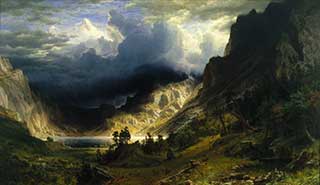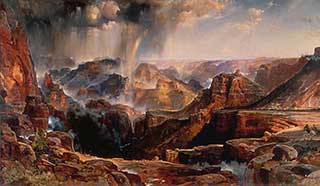
Light on the Dark Side: Images
and Reflections from Outer Space
- Phil MacGregor
_______________________________

Fig. 7. Al. Bierstadt, A Storm in the Rocky Mountains, 1866 

For the most detailed, and exhaustive connection of space imagery and the sublime, the recent work of Kessler (Op. cit.) decisively places Hubble imagery in the long Romantic tradition. Her work traces the explicit ties of space photography presentation to the inspiration of the American versions of the Romantic sublime. The artists of the Hubble Heritage Project acknowledge their own debts to the romantic genre and to specific artists, which Kessler (Op. cit.) traces out through comparisons of Hubble photos with typical pictures of the genre. She shows how the hues chosen for Hubble images reflect the colours used to depict the landscapes of the American West, the yellows and oranges of the rocks. Blue, reminiscent of sky, is often placed at the top of the photos. The physical forms, the austere and strange pillars, or sheer cliffs and buttes, present a series of iconic forms that provide a familiar vocabulary on which the space art imagery consciously and unconsciously draw. Dramatic clouds in romantic painting prefigure the amorphous shapes in the cosmic realms. They already hold symbolic power as icons of ambivalence, marking boundaries between realms, and between the familiar and the alien. Light is used in the iconic The Pillars of Creation to provide three-dimensionality, just as in Romantic landscape painting, exploiting contrast to secure a sense of depth and recession. She believes the way the space photos are oriented, rarely having north as top, is decisive proof of the artists' desire to provoke landscape associations in the spacescape. Paintings like Bierstadt's A Storm in the Rocky Mountains — Mt. Rosalie (fig. 7) and Moran's Chasm in the Colorado (fig. 8), painted in the late nineteenth century, draw upon a reservoir of familiar tropes for public reception. On her reading of Kant's sublime, where, to qualify, the sensual appeal of an image should induce disturbing rational activity, she traces a recurrent theme of the sublime through spacescapes and artistic image processing. She re-names it the “astronomical sublime.” It has to be said that her reading of Kant is not identical with Elkins' and is rather more linked to popular conceptions of Romanticism. The requirement of both Kant and Burke (Op. cits.) for the sublime to produce displeasure and terror is less emphasized by Kessler. The underlying point here is that, Elkins apart, Romantic aesthetics are shown to be a salient part of the production processes and inscribed meanings of a certain class of space photography from telescopes and space cameras.
Space Photography Online
News values — which I will argue are linked to aesthetics — are a measure of what defines the public appeal of website content. Images are abundant in this magazine-style genre of journalism, especially in the Guardian. It is unusual if the website's six top space stories — the ones near the top of the screen — do not have a picture with a distinct aesthetic appeal as well as ones that are topical. In print news nothing like such a prolific number of beautiful pictures have previously been reproduced.
The attraction depends on colour intensities, light, and form, so the screen perhaps does better justice to their attractions than newsprint reproduction. The pictures' spectacular qualities and variety of forms seem to strike a public chord, not just in journalism. Some reactions are visible in the comment sections of websites, and in many cases are led by a suggestive word or phrase in the headline “heavenly halo,” “stunning,” and “beautiful.”
The vocabulary of analysis of many of these “beautiful” shots can indeed be taken from the historical legacy of the romantic sublime. Births of stars, explosions of unimaginable intensity, gargantuan flows of charged particles across half a galaxy, storms on the gas giant Saturn, black holes swallowing stars, all these represent extremes of physical potency not found on earth and that break down our powers of representation, such is their scale. Power, Burke's primary condition for the sublime, seems to be fulfilled. Mystery, ambiguity, darkness, uncertain meanings, insecure explanations — these qualities abound.
Infinity stares at us from shot after shot of photo galleries reproduced in the news websites, especially those of the Guardian and Cosmic Log. Even though usually the images have some conceptual explanation, these are often so huge they beg the question of the unimaginable. They depict states of starry matter from billions of light years into the past that also show grand ideas such as the ultimate fate of our universe. By positing the boundaries of the finite, they invite contemplation of the infinite, so the limits of knowledge are implied, and, to use Burke's term, the imagination is confounded.
Of course, in everyday words, these emotions are all too often expressed in website comment sections in clichéd terms — “awesome,” “breath-taking” — and some are indeed uncomplicated responses. The eighteenth-century sublime, by contrast, has an absolute quality that includes unmediated, pristine awareness and the ensuing shock of an overwhelming terror and wonder. The modern expression and experience is qualitatively changed from the nineteenth century reaction to specialist art. As Elkins (Op cit.) maintains, the true sublime is limited to a period. It is fanciful to expect it to transfer directly to 21st-century consciousness. Nevertheless there is an intermediate position. To be sure, modern experience has a postmodern element of déjà vu, numbness, and repetition, and with many genres of imagery, we have been around the block several times already. There is, even so, something of the same sublime qualities of Burke's descriptions that are apparent in “pretty pictures,” at least a formal similarity and alignment with his terms — of vastness, wonder, obscurity, invocations of infinity, and what in modern usage would be called awesomeness. Cultural memory and reinterpretation over time allow forms and traces of structures of reaction received from the past to persist, even when they are recognized in neither the same words, nor identical feelings, and that is what is happening with popular space imagery and traces of the sublime.
If we move to Kant's dynamic sublime rather than the mathematical sublime, the possibility of reading today's space images on news websites with his species of the aesthetic seems tenable. The images stimulate encounters with infinity, as described. They also foreground the comforting power of intellectualism, the ability of the mind to distance itself from the paralyzing impression of raw natural phenomena. However threatening the physical events may be, there is an escape provided by mental contemplation, especially since these phenomena are truly so extraordinarily distant in time and space.


